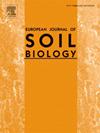Tracking assimilation of microbial biomass, leaf litter and artificially created soil organic matter by soil fauna using multi-resource stable isotope labelling
IF 3.3
2区 农林科学
Q1 ECOLOGY
引用次数: 0
Abstract
Understanding the resource utilization of soil invertebrates is essential for elucidating nutrient cycling and energy flow in terrestrial ecosystems. The soil environment offers a wide range of resources to its consumers, including microbes, soil organic matter (SOM), and plant litter. Soil invertebrates are small and cryptic, and typically rely on diverse arrays of basal resources, making the determination of its specific contributions to the diets of distinct animal groups challenging. This study investigated the carbon and nitrogen flows from different organic resources to soil meso- and macrofauna using stable isotope dual-labelling (13C and 15N) in an experimental temperate forest mesocosm over a one-month period. Studied resources included bacterial and fungal biomass, leaf litter and artificial mineral-associated organic matter ‘a-MaOM’ made of microbial necromass and vermiculite – a newly developed substrate produced in-house to experimentally mimic stabilized SOM. Our findings indicate that mesofauna incorporated the isotopic label from bacteria and fungi within three days after label introduction, demonstrating their role as primary microbial consumers in soil food webs and highlighting the importance of microbial biomass as nutrient sources for soil mesofauna. In contrast, macrofauna showed no detectable label uptake during the entire experimental period, suggesting either dietary preferences for other, unidentified resources or reflecting physiological factors such as lower metabolic turnover and slower assimilation of labelled materials. No detectable label was found in the studied invertebrate groups in the a-MaOM and litter treatments during the short experimental period, indicating that its consumption by soil fauna was negligible in comparison to microbial biomass. Beyond feeding ecology, our study introduces a methodological innovation by producing stable 13C- and 15N-labelled a-MaOM, offering a new tool for experimentally tracking stabilized SOM pathways in soil food webs while its bioavailability to soil organisms remains to be studied. Overall, our results reveal distinct feeding strategies among soil invertebrates, emphasizing the importance of mesofauna-microorganism interactions in soil nutrient cycling and the differentiated feeding modes of meso- and macrofauna in temperate forest ecosystems.

利用多资源稳定同位素标记跟踪土壤动物对微生物生物量、凋落叶和人工土壤有机质的同化
了解土壤无脊椎动物的资源利用对阐明陆地生态系统养分循环和能量流动具有重要意义。土壤环境为其消费者提供了广泛的资源,包括微生物、土壤有机质(SOM)和植物凋落物。土壤无脊椎动物体型小且隐蔽,通常依赖于各种各样的基础资源,这使得确定其对不同动物群体饮食的具体贡献具有挑战性。本研究利用稳定同位素双标记(13C和15N)研究了在一个月的实验温带森林中生态环境中,不同有机资源向土壤中、大型动物的碳氮流动。研究资源包括细菌和真菌生物量、凋落叶和人工矿物相关有机物质“a- maom”,由微生物坏死块和蛭石组成,蛭石是一种新开发的衬底,用于实验模拟稳定的SOM。我们的研究结果表明,中食性动物在标签引入后3天内就吸收了细菌和真菌的同位素标签,这表明它们在土壤食物网中是主要的微生物消费者,并突出了微生物生物量作为土壤中食性动物营养来源的重要性。相比之下,在整个实验期间,大型动物没有显示出可检测到的标签摄取,这可能表明它们对其他未知资源的饮食偏好,或者反映了生理因素,如较低的代谢周转和较慢的标签物质同化。在较短的实验时间内,在a-MaOM和凋落物处理的无脊椎动物组中没有发现可检测到的标签,这表明与微生物生物量相比,土壤动物的消耗可以忽略不计。除了喂养生态学,我们的研究还引入了一种方法创新,通过生产稳定的13C-和15n标记的a- maom,为实验跟踪土壤食物网中稳定的SOM途径提供了一种新的工具,而其对土壤生物的生物有效性仍有待研究。总体而言,我们的研究结果揭示了土壤无脊椎动物不同的取食策略,强调了温带森林生态系统中中微生物相互作用在土壤养分循环中的重要性,以及中、大型动物不同的取食模式。
本文章由计算机程序翻译,如有差异,请以英文原文为准。
求助全文
约1分钟内获得全文
求助全文
来源期刊

European Journal of Soil Biology
环境科学-生态学
CiteScore
6.90
自引率
0.00%
发文量
51
审稿时长
27 days
期刊介绍:
The European Journal of Soil Biology covers all aspects of soil biology which deal with microbial and faunal ecology and activity in soils, as well as natural ecosystems or biomes connected to ecological interests: biodiversity, biological conservation, adaptation, impact of global changes on soil biodiversity and ecosystem functioning and effects and fate of pollutants as influenced by soil organisms. Different levels in ecosystem structure are taken into account: individuals, populations, communities and ecosystems themselves. At each level, different disciplinary approaches are welcomed: molecular biology, genetics, ecophysiology, ecology, biogeography and landscape ecology.
 求助内容:
求助内容: 应助结果提醒方式:
应助结果提醒方式:


